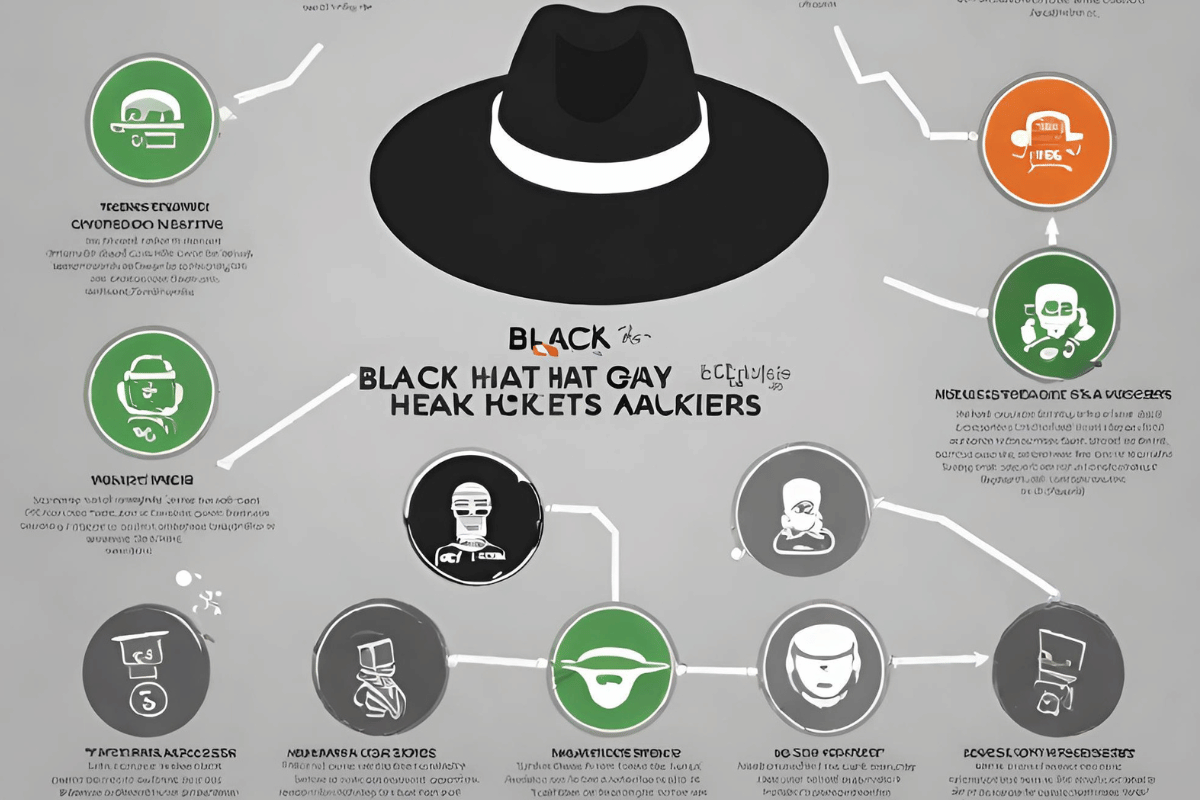Hackers employ various techniques to achieve their goals in today’s digital landscape. These include phishing, malware, brute force, social engineering, and DDoS attacks. Hackers come in different shades, such as black hat hackers driven by personal gain, white hat hackers who protect systems, gray hat hackers who bridge the gap, hacktivists with ideological motives, and script kiddies with limited skills.
Understanding Hacker Motivations:
1. Hacking for Profit
One of the most prevalent motivations for hackers is financial gain. These hackers, often called “black hat hackers,” are motivated by the prospect of making money through illicit means. They may engage in activities such as stealing credit card information, conducting ransomware attacks, or selling stolen data on the dark web.
Identity theft is a subset of hacking for financial gain. Hackers specializing in identity theft focus on stealing personal information, such as social security numbers and bank account details, to commit fraud and access financial assets.
3. Hacking for a Cause
Some hackers are driven by ideology or political beliefs. These “hacktivists” use their skills to further a cause they believe in. They may deface websites, leak sensitive information, or disrupt services to draw attention to their message.
4. Ethical Hacking
Ethical hackers, also known as “white hat hackers,” use their skills to identify vulnerabilities in systems and help organizations strengthen their cybersecurity. They do this with permission and play a vital role in protecting digital infrastructure.
5. Hacking for Thrills
For some individuals, hacking provides motivation. These “gray hat hackers” may not have malicious intentions but engage in hacking for the sheer excitement and challenge it offers.
Common Hacking Techniques:

1. Phishing Attacks
Phishing is a deceptive tactic used by hackers to trick individuals into divulging sensitive information such as passwords, credit card numbers, or personal details. These attacks typically take the form of fraudulent emails, messages, or websites that appear to be from legitimate sources.
How It Works?
- Email Phishing: Hackers send seemingly legitimate emails with links or attachments that, when clicked, lead to fake login pages or malware downloads.
- Spear Phishing: A targeted form of phishing where hackers personalize their messages to specific individuals or organizations, often using insider information to increase credibility.
- Clone Phishing involves creating a replica of a legitimate email, modifying it to contain malicious links or attachments, and sending it from a spoofed email address.
2. Malware Attacks
Malware, short for malicious software, encompasses a range of harmful programs that hackers use to gain unauthorized access, steal data, or control infected devices. Some common types of malware include viruses, Trojans, worms, and spyware.
How It Works?
- Virus: Infects files or software and replicates when the infected file is executed.
- Trojan: Appears as legitimate software but contains hidden malicious code, allowing hackers to gain access or steal data.
- Worm: Self-replicating malware that spreads across networks and devices, often causing widespread damage.
- Spyware: Secretly collects information about a user’s activities without their knowledge or consent.
3. Brute Force Attacks
Brute force attacks involve hackers systematically attempting every possible combination of passwords until they find the correct one. These attacks are time-consuming but can be effective against weak or easily guessable passwords.
How It Works?
- Dictionary Attacks: Use a predefined list of common passwords and words to guess login credentials.
- Credential Stuffing: Leveraging stolen username and password combinations from previous data breaches to access other accounts.
- Online Brute Force Attacks: Continuously try different password combinations until successful, often requiring significant time and computational power.
4. Social Engineering
Social engineering involves manipulating individuals into revealing confidential information or performing actions compromise security. Hackers exploit human psychology, trust, and emotions to achieve their objectives.
How It Works?
- Phishing Calls: Impersonating trusted entities over the phone to extract sensitive information.
- Pretexting: Creating a fabricated scenario to gain the victim’s trust and access information.
- Baiting: Offering something enticing, such as a free download, to lure victims into clicking on malicious links or downloading malware.
5. Distributed Denial of Service (DDoS) Attacks
DDoS attacks are designed to overwhelm a target’s server or network with an excessive traffic volume, causing it to become slow or unavailable. These attacks disrupt services and can be used for extortion, revenge, or diversion.
How It Works?
- Botnets: Hackers use networks of compromised computers (botnets) to flood the target with traffic.
- Amplification: Attackers exploit vulnerable systems to amplify their attack traffic, making it more potent.
- Application Layer Attacks: Targeting specific applications or services to exhaust server resources.
Types of Hackers:

Black Hat Hackers
Black hat hackers are often portrayed as the “bad guys” in the hacking world. They engage in malicious activities for personal gain or to cause harm. Their actions may include stealing sensitive information, spreading malware, conducting cyberattacks, and engaging in cybercrime. Black hat hackers operate in secrecy and often have criminal intent.
White Hat Hackers
White hat hackers, on the other hand, are the ethical heroes of the hacking community. They use their technical skills to identify vulnerabilities in computer systems and networks with the explicit permission of the system owners. Organizations employ white hat hackers to perform penetration testing and security assessments to strengthen their defenses and protect against potential threats. Their actions are legal and designed to improve cybersecurity.
Gray Hat Hackers
Gray hat hackers fall somewhere in between black hat and white hat hackers. They may uncover vulnerabilities in systems without authorization but often choose to disclose these vulnerabilities to the affected parties. While their intentions are not inherently malicious, their actions can sometimes be legally questionable. Gray hat hackers might operate in a morally ambiguous space.
Hacktivists
Ideological or political motivations drive hacktivists. They use hacking as a means of protest or to advance a particular cause or agenda. Their actions may include defacing websites, leaking sensitive information, or disrupting online services to draw attention to their message. The line between hacktivism and cybercrime can be blurry, depending on the actions taken and the jurisdiction’s laws.
Script Kiddies
Script kiddies are often inexperienced and lack the technical expertise of more seasoned hackers. They typically rely on pre-written scripts or tools to carry out hacking activities. While they may not fully understand the intricacies of hacking, script kiddies can still cause harm by launching attacks using readily available resources. Their motivations can vary but are typically driven by curiosity or a desire for notoriety.
State-Sponsored Hackers
State-sponsored hackers are individuals or groups supported and funded by governments to conduct cyber espionage, sabotage, or warfare. Their motivations align with the interests of their respective nations, and they often target other nations’ infrastructure, organizations, or government entities. State-sponsored hacking can have significant geopolitical implications.
Protecting Against Hacking:

Utilize complex, unique passwords for each account and consider using a password manager to track them. This simple step can thwart many brute-force attacks.
2. Update Software Regularly
Hackers often target known vulnerabilities in outdated software. Keeping your operating systems and applications up to date can prevent these exploits.
3. Implement Security Measures
Utilize firewalls, antivirus software, and intrusion detection systems to add layers of protection to your digital infrastructure.
4. Conduct Security Audits
Regularly assess your cybersecurity posture through audits and penetration testing. Identify and address weaknesses before hackers can exploit them.
Conclusion:
The world of hacking is multifaceted, with hackers motivated by various factors and employing various tactics. The diversity within this realm is extensive, from the profit-driven black hat hackers to the ethical white hat hackers who work to enhance security. Individuals and organizations must stay informed about the common tricks hackers use and the different types of hackers.
FAQs:
What are some common tricks that hackers use?
Hackers’ Common tricks include phishing attacks, malware distribution, brute force attacks, social engineering, and Distributed Denial of Service (DDoS) attacks. These tactics are often employed to gain unauthorized access, steal data, or disrupt services.
What motivates hackers to engage in cyberattacks?
Hackers can be motivated by various factors, including financial gain, ideological or political beliefs, the thrill of hacking, or ethical reasons. Understanding their motivations is essential in combating cyber threats effectively.
How can individuals and organizations protect themselves from hacking attempts?
Implementing strong password practices, educating and training employees about cybersecurity, regularly updating software, and employing security measures such as firewalls and antivirus software are key steps in protecting against hacking attempts. Additionally, conducting security audits can help identify and address vulnerabilities.
Why is staying informed about the different types of hackers important for cybersecurity?
Staying informed about different hacker types and their tactics is crucial for recognizing potential threats and vulnerabilities. It allows individuals and organizations to proactively protect themselves from cyberattacks and minimize the risk of falling victim to hacking attempts.
What is the first line of defense against cyber threats?
The first line of defense against cyber threats is knowledge and awareness. Being well-informed about common hacking techniques, hacker motivations, and best cybersecurity practices is essential in safeguarding digital assets and sensitive information.
